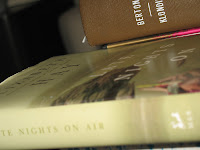 The Horseman’s Graves, Jacqueline Baker’s engrossing novel set in the Sand Hills near the Saskatchewan-Alberta border breaks like dawn, and carries on through the entire lives of two different, yet ultimately tied families, the Schoffs and the Krausses, until the sun sets. Sculpted by the landscape and drawn by their common experiences, the immigrants that populate the area farm, have families, and fill their days with work, their Sundays with church, and their idle time with talk.
The Horseman’s Graves, Jacqueline Baker’s engrossing novel set in the Sand Hills near the Saskatchewan-Alberta border breaks like dawn, and carries on through the entire lives of two different, yet ultimately tied families, the Schoffs and the Krausses, until the sun sets. Sculpted by the landscape and drawn by their common experiences, the immigrants that populate the area farm, have families, and fill their days with work, their Sundays with church, and their idle time with talk.
The Schoffs, second generation and still bearing the grudge held on between the two families, have lived next to the Krausses since settling in the area. The only Krauss left on the land, Leo, is scorned by the community as much for being a Krauss as for his odd, rude and sometimes shocking behaviour. Stolanus Schoff and his wife Helen, suffer their own ostracism after their only son endures a terrible wagon accident when small, growing up hideously scarred and suffering from seizures. Leading deceptively simple and separate lives, the two families carry on: Leo marries, the boy grows, crops come in, Stolanus prospers, Leo’s wife Cecelia bares five children in quick succession. And yet, like so many lives that look simple from the outside, bad luck, a curse even, tears through every inch of it, defining the actions of each person, charting a course that can’t be changed.
Until one long, dark night, the stuff of ghost stories, or even just old stories, the kind that Lathias, the Schoff’s Métis farmhand, tells to the boy on the long days they spend wandering the countryside or riding out to the river, when Leo’s stepdaughter, Elisabeth, goes missing and the days can no longer continue in that long stretch of just living, and everything changes. And if there are moral judgments upon change, upon the actions of the characters, the narrative doesn’t make them, instead lays back and lets the wind carry the words over the fields on a midsummer day before the harvest, quietly letting the reader make up his or her own mind about the story.
Now that I’ve read The Horseman’s Graves, the last of the three books from this infamous article in Maclean’s last summer, the article makes even less sense to me, so it’s a good thing I’m not a leading literary columnist for that magazine. Comparing and contrasting Effigy, The Outlander, and The Horseman’s Graves feels strange and out of step. And while each of the authors, all three women, have somewhat familiar settings, the stories are so different, the voices so distinct, that it does them a disservice to come out and crown The Outlander as the winner in a race not one knew they were entering.
Rich characterization, strong female protagonists, unavoidable (and in the case of Mary Boulton, crashed headlong into) tragedy and Western settings are about all that they have in common. Sure, York’s novel finds its basis in Mormonism, but it stretches out so far beyond that, that the religion comes to be something akin to the land they work, a foundation. And sure, the church is present in Baker’s story too, but it’s not oppressive, anything but, even if I’m clinging to a particularly beautiful passage when Leo Krauss forces his second wife Mary to her knees and they prey, shoulder to shoulder in the kitchen. The idea of the graveyard hold the community together in The Horseman’s Graves; I didn’t find this overwhelming or even maudlin, nothing more than a simple fact, an aspect of community, a lasting remnant of the lives that fill up the past of the story the author’s trying to tell.
York’s epic story, Adamson’s epic novel, Baker’s epic tale, all three are really good books, books worth reading and talking about, worth sharing and passing along, and perhaps not for lumping together and taking apart, bit by bit, the long hours each spent bent over their own words in their heads, working their fingers out as much as the stories themselves, only to come to the conclusion that one of them is worth more of someone’s time than another. Seems strange to me, an article written with an agenda versus a true need to simply state an interesting observation. It’s funny, if I were to take a look at each of the novels and dissect them, say for a large national magazine, I would have probably started with the idea that each novel’s taken a little bit of history, whether it’s an actual character who lived and breathed before the pages or an event, and used it to build a fascinating world within their books, adding a layer to stories that already exist, and telling them in a way that makes the world richer, and doing all of this with strong, rich, and intriguing voices.
PHOTO IN CONTEXT: Baker’s book on my kitchen table, a fitting place for a story about and defined by the idea of family.
READING CHALLENGES: I read The Horseman’s Graves for Saskatchewan in The Canadian Book Challenge.






